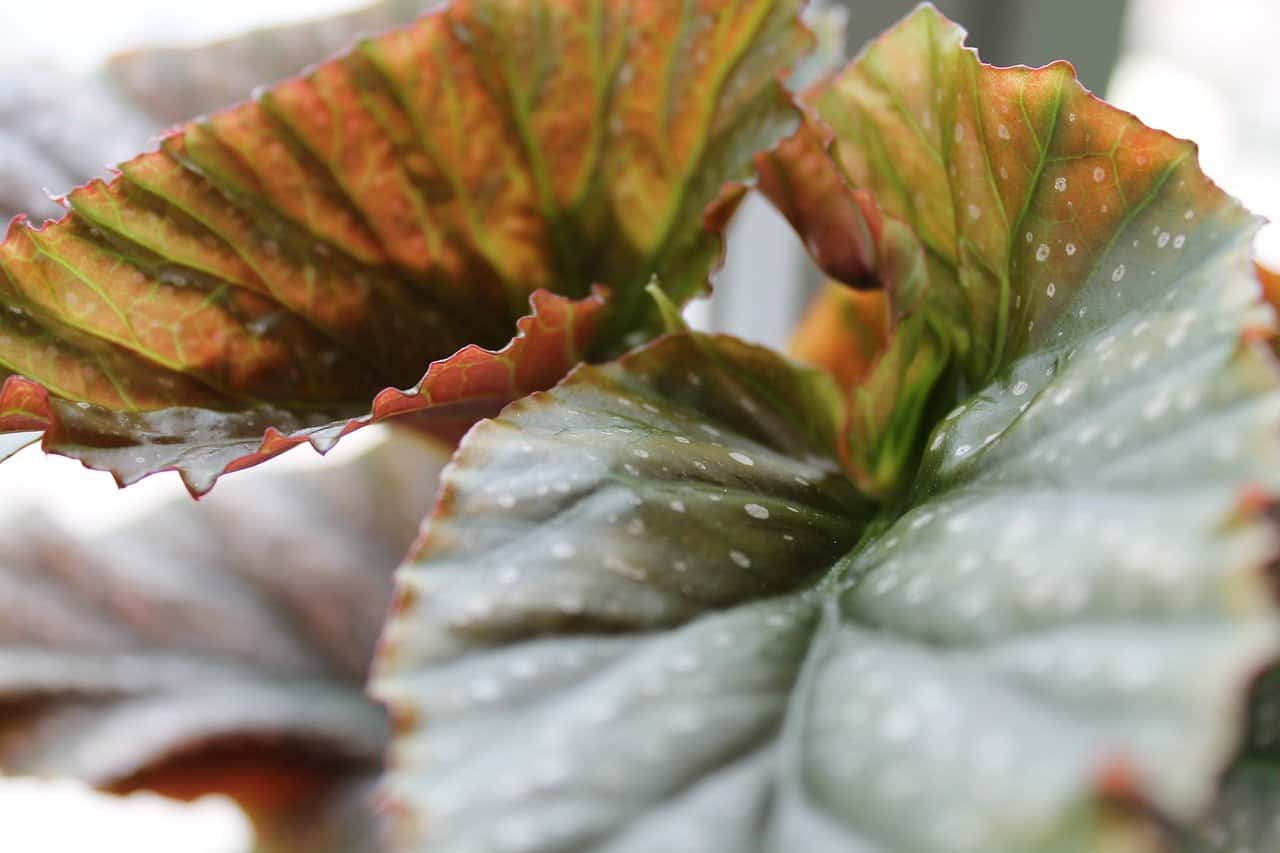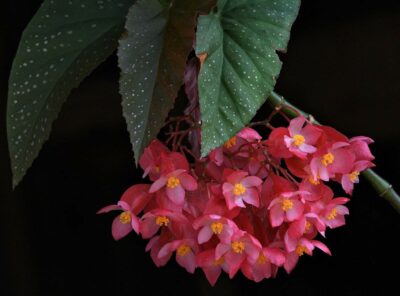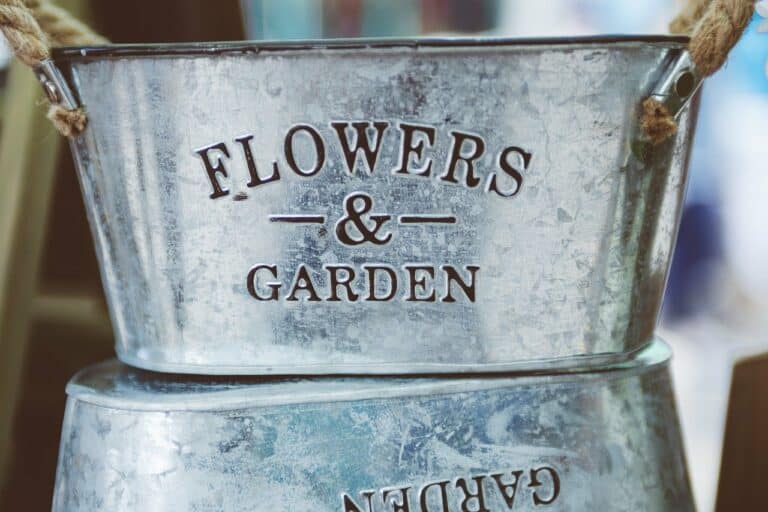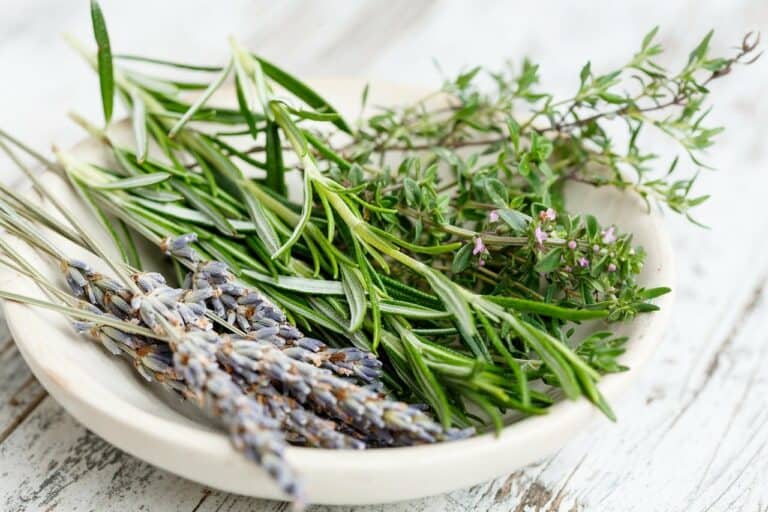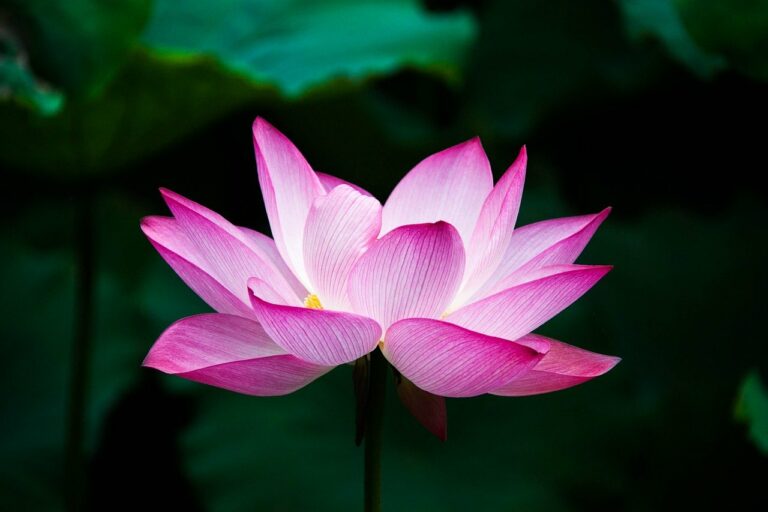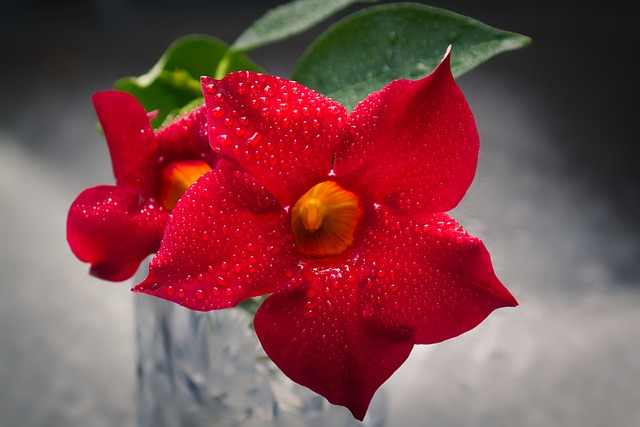Table of Contents
Begonia Corallina de Lucerna – Learn The Facts
Are you looking for something different to add to your houseplant collection? How about a houseplant with a history? Begonia ‘Corallina de Lucerna’, also known as the angel wing Begonia or as Begonia lucernae, is an heirloom houseplant that has been around for 100 years or more.
Keep reading everything you need to know about Begonia ‘Corallina de Lucerna’ care and how to grow this stunning plant indoors!
| Name(s) | Begonia ‘Corallina de Lucerna’, angel wing Begonia, Begonia lucernae |
| Difficulty level | Intermediate |
| Light | Bright indirect |
| Water | Keep lightly moist |
| Soil | Well-draining |
Natural Habitat & history
Begonia ‘Corallina de Lucerna’ is not a plant that exists in the wild: it’s a hybrid, meaning it was created by crossing two different Begonias. There are loads of hybrid houseplants, but the nice thing about this one is that it’s such an early example. There are a few different stories out there about how ‘Corallina de Lucerna’ came to be:
- It resulted from an 1892 project by Wettstein, who worked as a gardener in Lucerne, Switzerland. This hybrid was created from two parent plants, which were Begonia teuscheri and coccinea.
- Wettstein created it, but one parent is unknown, and the other is Begonia corallina (a synonym for Begonia maculate, the famous polka dot Begonia).
- Wettstein created a plant called Begonia coccinea ‘Lucerne,’ but this is not the Begonia ‘Corallina de Lucerna’ we know today. Instead, that was created by Eva Kenworthy Gray by crossing Wettstein’s Begonia coccinea ‘Lucerne’ with Begonia aconitifolia.
Whichever is the actual version of the story, we know that ‘Corallina de Lucerna’ has been around for a long time. It’s part of the ‘angel wing’ group of Begonias, whose ancestors primarily hail from a part of Brazil known as the Atlantic Rainforest.
The angel wings are also sometimes known as cane Begonias. They grow much taller than most other Begonia species and are characterized by their spotted leaves with reddish undersides.
Description
Although the angel wing group of Begonias fell out of fashion for a good while, it’s easy to see why hybrids like Begonia ‘Corallina de Lucerna’ have come back. They’re stunning, classic ‘pass-it-along’ plants that sometimes become a bit of a family heirloom.
‘Corallina de Lucerna’ is characterized by olive to dark green leaves with fine white dots and reddish-purple undersides. The wing-shaped angel foliage grows on thick, somewhat cane-like stems, which can reach enormous sizes when grown in the right conditions! A bonus is this houseplant flowers indoors, producing clusters of lovely pink blooms.
Light
Begonia ‘Corallina de Lucerna’ is the product of parent plants that naturally form part of the rainforest understory. Because most of the sun’s direct rays are blocked out by taller trees, this species hasn’t evolved to need vast amounts of light to thrive. It should be near a window to prevent it from growing lanky, but too much direct sun should be avoided, mainly if the plant hasn’t been properly acclimated.
You can also grow ‘Corallina de Lucerna’ under artificial lighting.
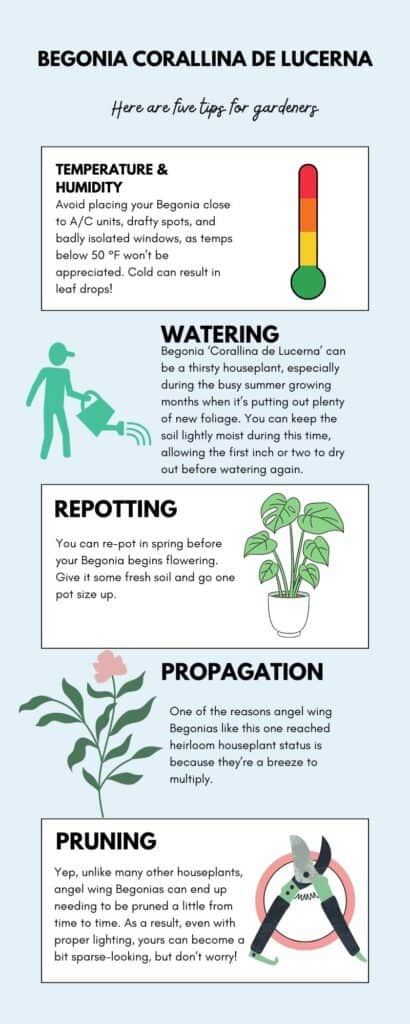
Temperature & humidity
Temperature
Like most of our favorite houseplants, this is tropical, which means it doesn’t appreciate the cold. Room temperature is acceptable: if you feel comfortable in your home, the same goes for your Begonia ‘Corallina de Lucerna.’ Warmer temperatures aren’t a problem either.
Avoid placing your Begonia close to A/C units, drafty spots, and badly isolated windows, as temps below 50 °F won’t be appreciated. Cold can result in leaf drops!
Humidity
Are you having trouble getting your Begonia ‘Corallina de Lucerna’ to thrive? One common problem houseplant enthusiasts encounter with angel wing Begonias like this is humidity. But, again, its ancestors are rainforest plants. These species naturally grow in environments where the air humidity can reach 100%.
Our homes are generally drier than the average rainforest, especially during the winter. This can lead to leaf drop, crisping, and lack of flowering. If you don’t have a cheap humidity meter on hand yet, be sure to get one! Angel wing Begonias prefer 50%+ humidity year-round.
Consider running a humidifier if your humidity meter reveals lower air moisture levels. Then, all of your tropical houseplants will thank you, not just your Begonia.
Watering
Begonia ‘Corallina de Lucerna’ can be a thirsty houseplant, especially during the busy summer growing months when it’s putting out plenty of new foliage. You can keep the soil lightly moist during this time, allowing the first inch or two to dry out before watering again.
Never leave the plant in waterlogged soil, as that’s a recipe for root rot! Remember, overwatering is probably the primary cause of death in indoor plants. If you’re unsure whether it’s time to water again yet, stick a finger in the soil to gauge its moisture level. If it still feels evenly damp, give it a few more days.
During the cooler winter months, when houseplants don’t grow nearly as much, you can let your Begonia’s soil dry about halfway. If you wish your plants to live a long, happy and healthy life, it is important not to let the soil dry to the bone: If the leaves are drooping or beginning to drop, you may have waited too long.
Soil & Repotting
Soil
The right soil mixture is the key to a healthy houseplant, and this is no exception. Unfortunately, common houseplant potting soil without additives doesn’t offer the drainage that Begonia ‘Corallina de Lucerna’ needs. Excess water should be able to flow freely from the planter because, as mentioned above, wet feet are a one-way ticket to root rot land.
Thankfully, mixing your Begonia soil at home is easy enough. A good starting point would be to use potting soil; however, you can just mix in a handful of a gritty element like perlite or fine orchid bark to ensure it drains well.
Repotting
A well-cared-for Begonia ‘Corallina de Lucerna’ can be a pretty vigorous plant, meaning that if yours is doing well, it will likely need repotting every year. You can re-pot in spring before your Begonia begins flowering. Give it some fresh soil and go one pot size up.
Don’t forget to always use a container with a drainage hole in the bottom. If you tend towards overwatering, it can be helpful to go for an unglazed terracotta planter, as this porous material allows moisture to evaporate more quickly than plastic or ceramic.
Fertilizer
If your Begonia ‘Corallina de Lucerna’ is healthy and regularly putting out new foliage, it will appreciate a little extra boost during the summer months. You can use a regular liquid houseplant fertilizer every other week according to the instructions on the bottle.
Be sure not to use plant food during the slow winter months or if your plant isn’t doing well. You’re not giving it a boost this way; the excess fertilizer can damage the roots.
Propagation
One of the reasons angel wing Begonias like this one reached heirloom houseplant status is because they’re a breeze to multiply. If you’d like to take cuttings from your Begonia ‘Corallina de Lucerna’ to sell, give away or just expand your collection, all you have to do is cut the tops off a few of the stems (2-3” will be enough). Then, include a few leaves at the top and make sure your cuttings have a couple of nodes (growth points).
You can pop the stems directly into the soil to root, in which case it can be a good idea to place them in a propagator to increase humidity and give the new plants a healthy start.
Furthermore, if you prefer not to use soil propagation, you can also use water propagation, letting the cuttings root in a glass or vase before transferring them to soil later. This Begonia is easy to establish either way!
Once you see the first new leaves pop up, you’ll know that your cutting has rooted and created a brand new plant.
Pruning
Yep, unlike many other houseplants, angel wing Begonias can end up needing to be pruned a little from time to time. As a result, even with proper lighting, yours can become a bit sparse-looking, but don’t worry! Using the propagation methods described above, it’s easy to keep your plant looking its best.
If you think it’s time to get some shape back into your Begonia ‘Corallina de Lucerna,’ here’s what you can do:
- First, prune by cutting the tips off as many stems as you’d like.
- Then, place the stems back into the mother plant’s container to achieve a fuller look or root them separately.
- The beheaded stems will grow back and usually branch out as they do so, contributing to a fuller appearance.
Conclusion
Begonia ‘Corallina de Lucerna’ is a stunning houseplant with a long history. Some indoor gardeners struggle with their angel wing Begonias losing leaves due to lack of humidity or other issues, but with a few tweaks, yours should be able to grow gloriously tall and be more than worth the effort!
How to grow and care for Begonia lucerna Indoors
|| How to Grow Angel Wing Begonia Indoors – Tips and Tricks ||


